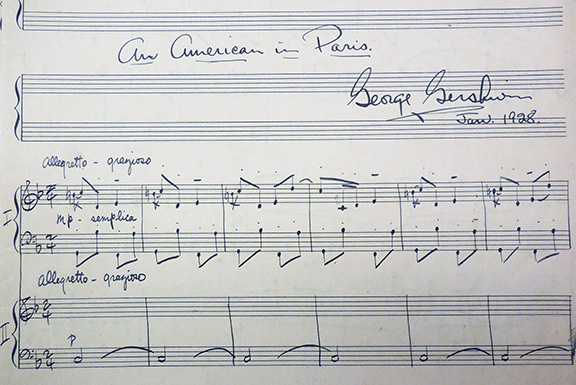By Andy Fein and Martha McDermott
Not many pieces of classical music can claim to have inspired a series of ballets, movies, and musicals, but Gershwin's 'An American in Paris' has done all of that!
Written after Gershwin's other wildly popular jazz influenced concert pieces 'Rhapsody in Blue' and 'Piano Concerto in F', 'An American in Paris' had big musical shoes to fill, and it did. It debuted December 13, 1928 becoming instantly popular with many subsequent performances. Even after
Gershwin's untimely death nine years after its debut. 'An American in Paris' is actually one of the most performed orchestral works of the 20th century. However, the concert hall is not the end of this piece's journey.
The journey of an American in Paris begins in 1926 during a trip to Paris. As a gift to his host family, Gershwin wrote a small piece called Very Parisian which was expanded two years later into An American in Paris. During that trip he also purchased pitched taxi horns to be used during the performance, to more authentically replicate the sound of Parisian streets.
Gershwin described his finished product as a "rhapsodic ballet" and "the most modern music I've yet attempted." The debut performance on December 13, 1928 was conducted by former New York Philharmonic Society director Walter Damrosch at Carnegie Hall. The concertmaster of that performance was Italian violinist Scipione Guidi. A fun fact about Guidi is that two years later, in 1930, he acquired a 1772 J. B. Guadagnini violin which he played for the rest of his life.
The first use of choreography with the piece was an abridged version during the Gershwin musical 'Show Girl' in 1929. Albertina Rasch did the choreography and Duke Ellington conducted the pit orchestra for the Broadway production.
 |
| Signed piano score of 'An American in Paris'- University of Michigan collection |
Gershwin described his finished product as a "rhapsodic ballet" and "the most modern music I've yet attempted." The debut performance on December 13, 1928 was conducted by former New York Philharmonic Society director Walter Damrosch at Carnegie Hall. The concertmaster of that performance was Italian violinist Scipione Guidi. A fun fact about Guidi is that two years later, in 1930, he acquired a 1772 J. B. Guadagnini violin which he played for the rest of his life.
 |
| Scipione Guidi looking at his Guadagnini- St. Louis Symphony Collection |
The first use of choreography with the piece was an abridged version during the Gershwin musical 'Show Girl' in 1929. Albertina Rasch did the choreography and Duke Ellington conducted the pit orchestra for the Broadway production.
Being a rhapsodic ballet, it is not surprising that following the piece's debut, choreographers were inspired to put movement to the piece. In 1936, Ruth Page brought Gershwin's piece to life with choreography for herself and Paul Draper.
The 1951 movie of the same name uses many classic George and Ira Gershwin tunes with the climax consisting a 16 minute ballet. This movie starred Gene Kelley and 17 year old french dancer Leslie Caron. Kelley not only starred in the film, he also choreographed it and assisted in casting it. Ira Gershwin wrote additional lyrics.
The 1951 movie of the same name uses many classic George and Ira Gershwin tunes with the climax consisting a 16 minute ballet. This movie starred Gene Kelley and 17 year old french dancer Leslie Caron. Kelley not only starred in the film, he also choreographed it and assisted in casting it. Ira Gershwin wrote additional lyrics.
 |
Gene Kelly and Leslie Caron in a dance number so hot it's smoking!
In 2005, Christopher Wheeldon choreographed 'An American in Paris' ballet for the New York City Ballet. He then later directed the premier of the stage musical version of the film in Paris in 2014. This year (2015) it had its Broadway opening, which won 4 Tony awards.
To borrow a song title from the movie 'An American in Paris', "S'wonderful" how much Gershwin's piece has inspired other creative artists. Despite the huge number of performances of the orchestral arrangement, you rarely hear a musician complain about having to play it. Again! The same can't be said for 'The 1812' or 'Canon' (you know which one I'm talking about!).
Have other pieces inspired a line of creativity? Of course! One of my favorites is Beethoven's "Kreutzer Sonata' which inspired a novella by Tolstoy, several plays, a paintings, and a string quartet Janacek.
A little inspiration can go a long way. Whether you're Beethoven, Gershwin, or someone else. Oh, and remember to get a claim on the residuals!
Are you a string musician or interested in becoming one? Take a look at our Fine Violins, Violas, and Cellos!

No comments:
Post a Comment